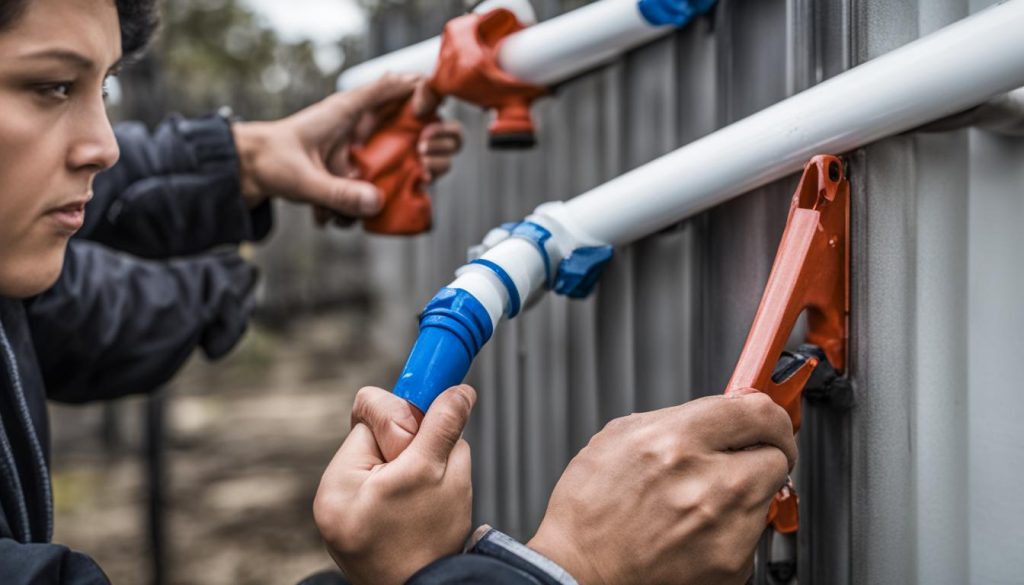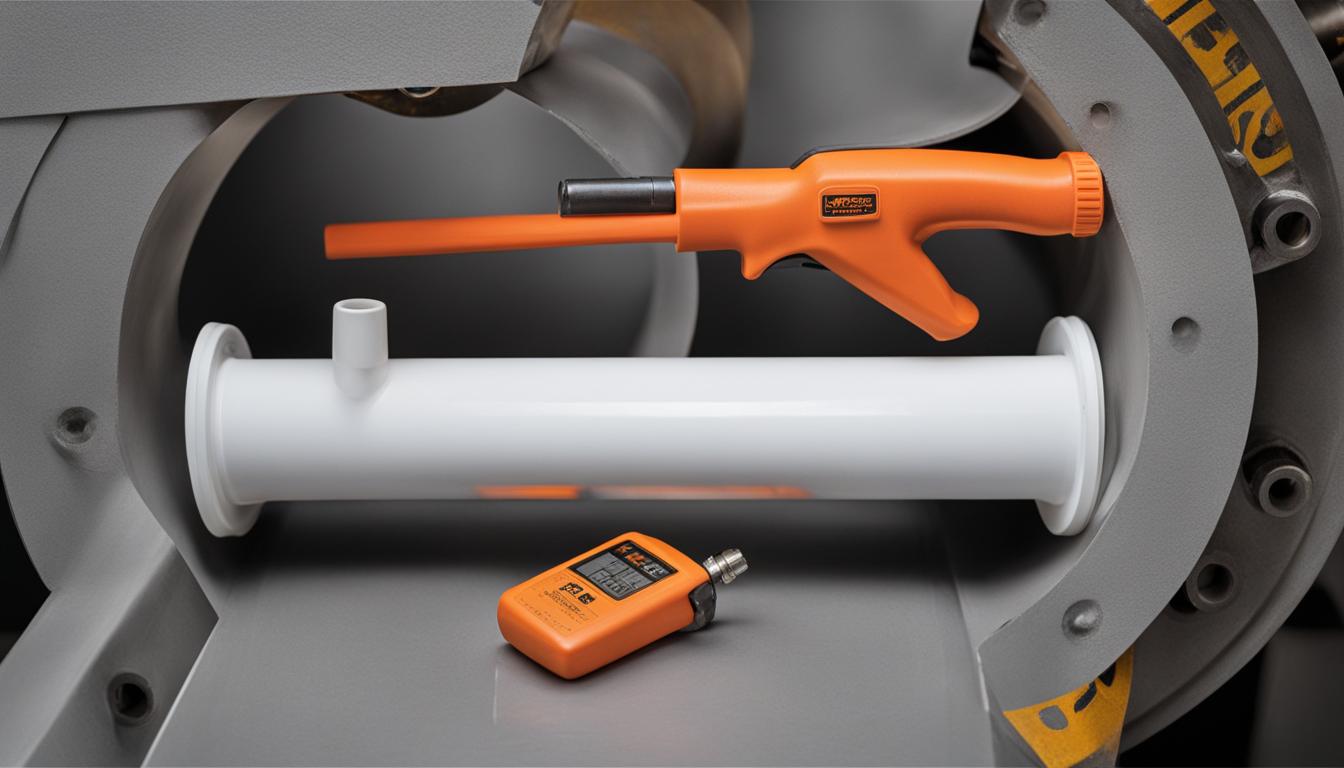Did you know that a weak or improperly secured PVC pipe fitting can lead to costly leaks and potential damage to your property? It’s true! A study found that water damage caused by plumbing failures is one of the leading causes of home insurance claims, with an average claim cost reaching thousands of dollars. That’s why it’s crucial to ensure that your PVC pipe fittings are securely tightened to prevent any potential issues.
Key Takeaways:
- Properly secure PVC pipe fittings to avoid leaks and potential damage.
- Perform a test-fit before applying PVC cement to ensure proper alignment.
- Clean both the pipe and fitting to remove debris that could affect the bond.
- Apply PVC cement to the fitting’s interior for a strong and permanent bond.
- Insert the pipe into the fitting and hold in place for approximately 30 seconds.
Conduct a Test-Fit
Before applying PVC cement, it is essential to conduct a test-fit to ensure that the components align correctly and fit together as desired. This step helps identify any potential issues before making a permanent connection.
- Start by dry fitting the PVC pipes and fittings without any adhesive.
- Ensure that the pipes are fully inserted into the fittings, with no gaps or obstructions.
- Check the alignment of the pipes and fittings to ensure they are straight and properly aligned.
- Make any necessary adjustments to ensure a proper fit.
- If the components do not align correctly, gently rotate or wiggle them until they fit together snugly.
- Once the test-fit is successful and the components align properly, proceed to the next step of applying PVC cement for a secure connection.
Performing a test-fit is crucial in preventing any issues or leaks in the future. Take the time to align and fit the components correctly, as this will ensure a strong and reliable connection.
A proper test-fit helps ensure that the PVC components align correctly.
Clean Both Components
Before applying PVC cement, it is crucial to ensure that both the pipe and fitting are clean and free from any debris or contaminants. This step plays a significant role in achieving a strong and secure connection.
Follow these steps to thoroughly clean both components:
- Inspect the pipe and fitting for any visible dirt, dust, or foreign particles.
- Use a clean cloth or rag to wipe away any loose debris.
- If necessary, rinse the pipe and fitting with water to remove stubborn dirt or residue.
- Ensure that both the pipe and fitting are completely dry before proceeding.
By removing any debris or contaminants, you provide a clean surface for the PVC cement to adhere to, resulting in a secure bond between the pipe and fitting.
Apply PVC Cement
When it comes to securing PVC pipe fittings for a strong and permanent bond, applying PVC cement is essential. The cement creates a secure connection by effectively melting the plastic surfaces and bonding them together. To ensure a successful bond, follow the steps below:
- Clean the interior of the fitting: Use a clean cloth or brush to remove any dust or debris from the interior of the fitting. This will ensure a clean surface for the cement to adhere to.
- Apply a small amount of PVC cement: Take a small brush or applicator and apply a thin layer of PVC cement to the interior of the fitting. Pay close attention to the area where the ‘stop’ or detent is located. This is where the bond will be the strongest, providing maximum security.
It’s important to note that PVC cement can be highly adhesive, so be careful to only apply a small amount. Excessive cement may cause dripping or overflow, which can be messy and compromise the overall quality of the bond. Additionally, always ensure proper ventilation when working with PVC cement to avoid inhaling any fumes.
Benefits of Using PVC Cement for Interior Bonding
By applying PVC cement to the interior of the fitting, you can achieve a secure and long-lasting bond. The melting action of the cement creates a seamless connection, preventing any leaks or separations. This is especially important for interior PVC pipe fittings, where a strong bond is crucial for maintaining the integrity of the plumbing system. Whether you’re working on a residential or commercial project, using PVC cement guarantees that your fittings will remain securely in place for years to come.
| Benefits of Using PVC Cement for Interior Bonding | |
|---|---|
| Strong and permanent bond | |
| Prevents leaks and separations | |
| Ensures the integrity of the plumbing system | |
| Long-lasting and reliable connection |
Insert the Pipe
Gently insert the pipe all the way into the fitting, making sure it seats securely against the stop. Hold the pipe in place for approximately 30 seconds to allow the PVC cement to create a strong and secure bond. If necessary, use assistance such as a mallet or a piece of wood to tap the pipe into place.
Use Assistance if Needed
If the pipe does not insert fully by hand, you can use a mallet or a piece of wood to gently tap the pipe into place. Be cautious not to apply excessive force, as it could damage the components or compromise the integrity of the connection.

Proper Techniques to Ensure a Secure Connection
When inserting PVC pipes into fittings, it’s important to ensure a secure and tight connection. In some cases, the pipe may require assistance to fully insert into the fitting. Here are some techniques to help you achieve a secure connection:
- Assess the fitting: Before using any assistance, make sure the fitting is clean and free from debris.
- Use a mallet or wood piece: If the pipe does not insert fully by hand, gently tap it using a mallet or a piece of wood. The aim is to encourage the pipe into place without applying excessive force.
- Be cautious of excessive force: Applying excessive force when tapping the pipe can cause damage to the fitting or compromise the connection’s integrity. Always use a gentle tapping motion.
- Check alignment: After tapping the pipe into place, check the alignment to ensure it is fully seated in the fitting and securely held in position.
By using these techniques, you can assist the insertion of the pipe while maintaining a secure and reliable connection.
Connect PVC using Fasteners
To create a temporary yet secure connection between PVC pipes and fittings, threaded screws can be used. This method provides a robust structural hold without the permanent bonding of PVC cement. It is ideal for projects that require flexibility and the ability to reuse or reposition fittings later on.
Here are the steps to connect PVC using threaded screws:
- Ensure the pipe is fully seated inside the fitting, allowing for a proper connection.
- Create a pilot hole using a drill bit. This hole will guide the screw and ensure it goes in straight.
- Insert a self-tapping threaded screw into the pilot hole, driving it firmly but carefully. Ensure the screw is aligned correctly with the fitting to establish a secure connection.
Using threaded screws provides a temporary solution that allows for disassembly and repositioning when needed. It offers the flexibility to adjust and modify your PVC pipe system without the permanent commitment of PVC cement. This allows for easier repairs or modifications in the future.
Advantages of Temporary Connection
Temporary connections using threaded screws offer several advantages:
- Flexibility: The ability to disassemble and reposition fittings provides flexibility for future modifications or repairs.
- No permanent bonding: Unlike PVC cement, which creates a permanent bond, temporary connections allow for future adjustments without the need for cutting or replacing pipes.
- Reusable fittings: Temporary connections allow you to reuse fittings in different projects, maximizing their longevity and value.
Comparing Connection Methods
| Connection Method | Permanence | Flexibility | Reusable Fittings |
|---|---|---|---|
| PVC Cement | Permanent | Limited | Not reusable |
| Threaded Screws | Temporary | High | Reusable |
| Push-to-Connect | Temporary | Variable | Reusable |
In comparison with PVC cement and push-to-connect fittings, threaded screws offer a temporary connection that combines robust structural hold with the flexibility to adjust and reuse fittings in different projects.
Push-to-Connect Fittings
Push-to-connect fittings offer a convenient and hassle-free method for connecting PVC pipes. These fittings eliminate the need for cement or fasteners, making installation quick and easy. With push-to-connect fittings, you can achieve a secure connection without any welding or adhesives.
However, it’s important to note that variations in manufacturing may result in fittings that are slightly loose. To ensure a secure connection, it is recommended to use the fastener connection technique. By employing this method, you can join any loose elements and ensure a robust and secure bond between the PVC pipes and fittings.
The fastener connection technique involves using additional fasteners such as screws to reinforce the connection. By adding this extra layer of security, you can have peace of mind knowing that your PVC pipe system is firmly and reliably connected. Whether you’re working on a DIY project or a professional plumbing installation, the fastener connection technique is a great way to enhance the stability and durability of your PVC pipe connections.
Source Links
- https://www.pvcfittingsonline.com/resource-center/pipe-fittings-sizes-guide/
- https://www.familyhandyman.com/project/how-to-glue-and-join-pvc-plastic-pipe/
- https://pvcfittingstore.com/pages/two-ways-to-connect-pvc-pipe-and-fittings
